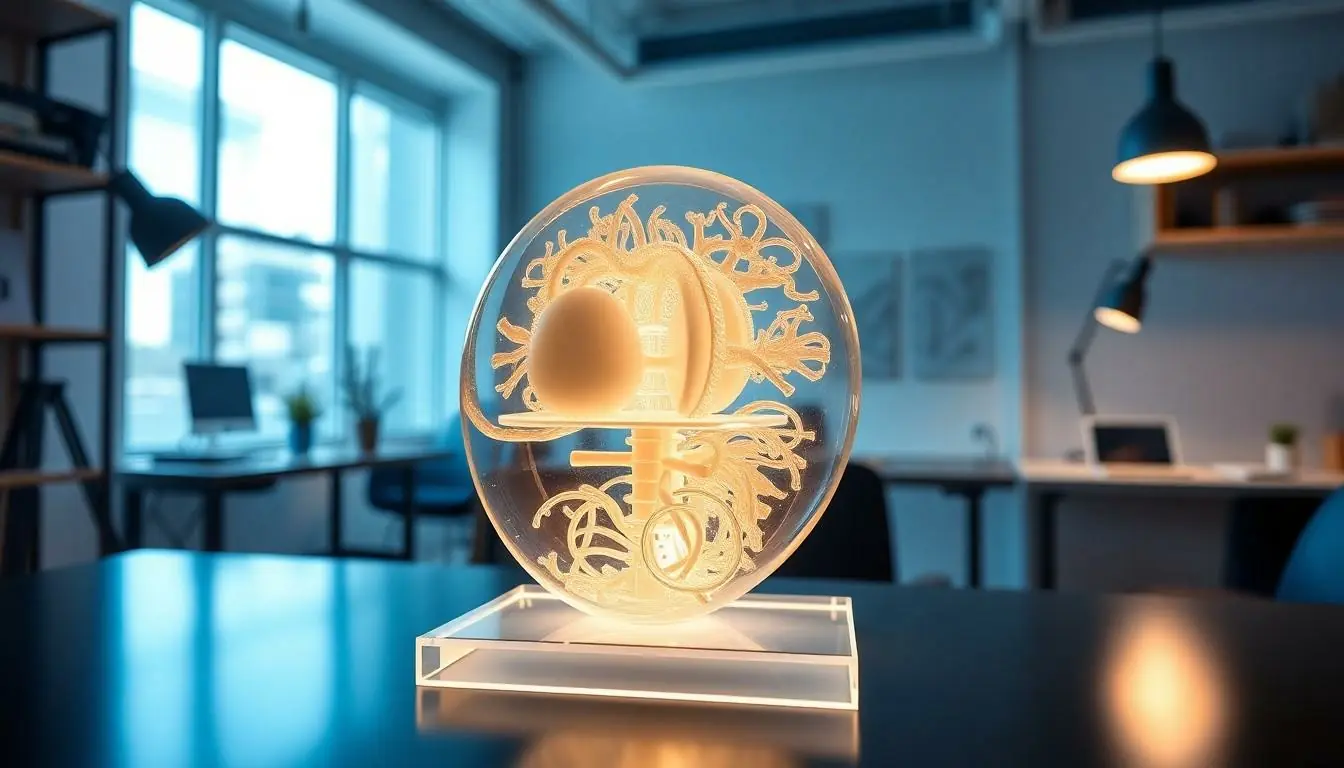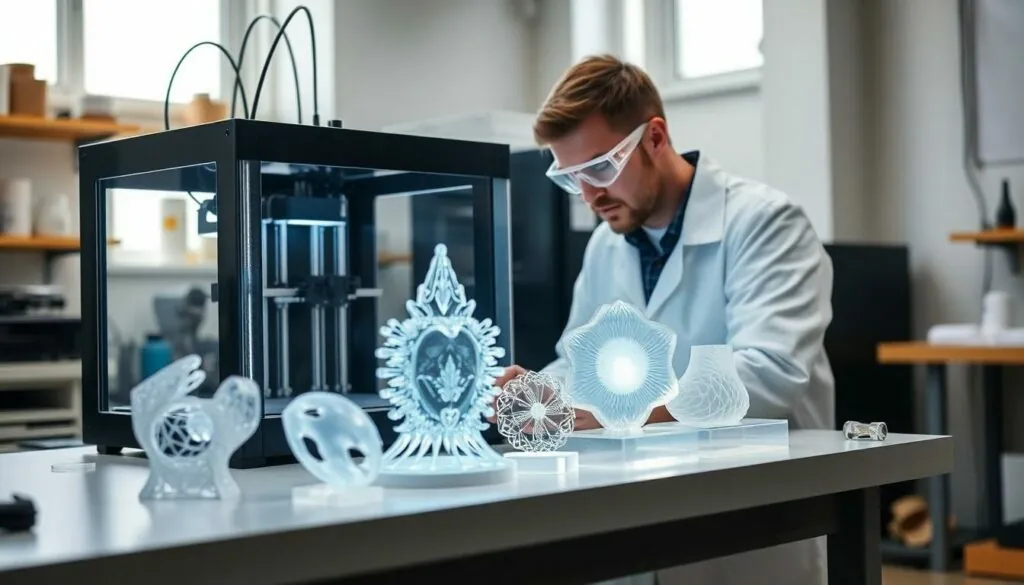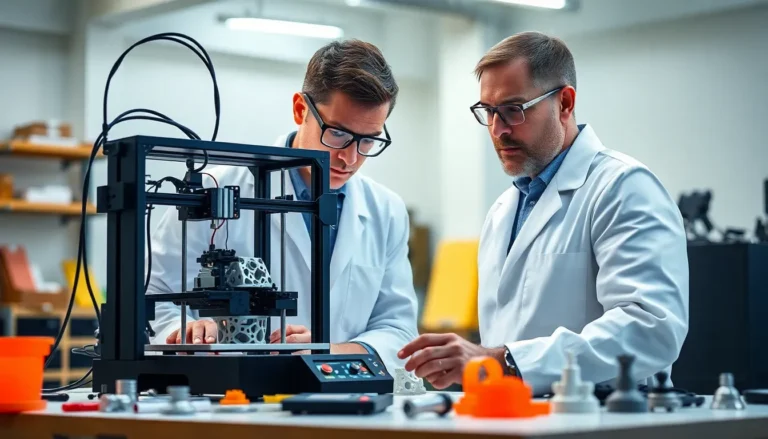Imagine holding a crystal-clear masterpiece that looks like it defied the laws of physics. Clear 3D printing is making this dream a reality, transforming how designers and creators approach their projects. With its ability to produce stunningly transparent objects, this technology is not just a gimmick—it’s a game changer.
From intricate prototypes to eye-catching displays, clear 3D printing opens up a world of possibilities. It’s like having a magic wand that turns your wildest ideas into tangible art. Plus, who wouldn’t want to impress their friends with a see-through sculpture that’s cooler than their last vacation? Dive into the fascinating realm of clear 3D printing and discover how it can elevate your creations to a whole new level.
Table of Contents
ToggleOverview Of Clear 3D Printing
Clear 3D printing represents a significant advancement in additive manufacturing, focusing on the creation of transparent objects. Significant benefits arise from this technology, particularly for industries such as architecture, product design, and art. Creators utilize specialized resins that cure into solid forms while maintaining clear properties.
Translucent materials allow for intricate designs and light manipulation, enhancing visual aesthetics. Unlike traditional opaque materials, clear 3D printing reveals internal structures, making it ideal for demonstrations. Design professionals harness this capability to showcase prototypes that require detailed internal views.
Applications extend to practical uses, including medical devices and consumer products. Medical professionals employ clear 3D printing for surgical guides, helping improve precision during operations. The consumer market benefits from clear components in packaging, providing an attractive way to display products.
Customization options increase with clear 3D printing, allowing designers to incorporate colors and textures without compromising transparency. The design flexibility leads to unique artistic expressions, solidifying its place in creative industries.
Quality control remains crucial, ensuring that printed objects meet clarity and durability standards. Industry leaders consistently research new materials and processes to enhance performance. Clear 3D printing technology continues to evolve, sparking innovations across different fields and inspiring countless creators.
Enhanced machine capabilities accelerate the printing process, reducing production times significantly. Together, these factors establish clear 3D printing as a transformative tool for designers, allowing for both functional and aesthetic advancements in their projects.
Benefits Of Clear 3D Printing

Clear 3D printing offers a range of benefits that enhance both aesthetic and functional aspects of design. This technology significantly improves the visibility of intricate details in printed objects.
Visual Appeal
Visual appeal stands out as a key benefit of clear 3D printing. Transparent objects catch light in unique ways, creating stunning visual effects that attract attention. Designers utilize this capability to showcase internal structures effectively, allowing viewers to appreciate complexity without intrusive barriers. Light manipulation leads to dynamic displays, making products visually engaging. Architects employ clear 3D printed models to present projects more compellingly, thus aiding client decisions. The ability to combine transparency with colors and textures enriches artistic expression while maintaining clarity.
Functional Advantages
Functional advantages also play a vital role in clear 3D printing. This technology supports varied applications in sectors like healthcare and consumer goods. Clear components are crucial for designing medical devices, as they facilitate better understanding of surgical guides through visibility. Designers incorporate clear elements into packaging, enhancing product appeal while ensuring functionality. Clarity allows for accurate representation of designs, improving clients’ and customers’ comprehension. Quick production times enable rapid prototyping, significantly reducing the time from conception to market. Overall, clear 3D printing enhances both practical utility and design effectiveness across multiple industries.
Applications Of Clear 3D Printing
Clear 3D printing finds diverse applications across fields, showcasing its versatility and innovative potential.
Prototyping
Prototyping benefits greatly from clear 3D printing. Designers create transparent models that reveal intricate internal structures. This transparency facilitates understanding and showcases complex designs to clients. The fast production times accelerate the prototyping process, allowing for quicker iterations and feedback. Companies leverage this technology to produce functional prototypes that directly reflect the final product. Enhanced visual clarity in prototypes helps teams identify possible design flaws early, streamlining development.
Art and Design
Art and design thrive with clear 3D printing. Artists use transparent materials to craft visually striking sculptures and installations. This medium allows for unique light manipulation, creating captivating visual effects. Designers incorporate clear elements into their work, merging aesthetics with functionality. Custom textures and colors further enhance artistic expression while preserving transparency. Collaborations between artists and technologists push creative boundaries, leading to innovative art forms that intrigue audiences.
Medical Field
The medical field embraces clear 3D printing for various applications. Surgeons utilize clear surgical guides to improve precision during operations. Transparency in these guides enhances visibility, allowing for better spatial understanding. Medical models crafted from clear materials aid in patient education, demonstrating complex procedures effectively. Additionally, customized anatomical models facilitate pre-surgical planning, ensuring optimal outcomes. Continuous advancements in clear 3D printing technologies promote the development of new solutions in healthcare, enhancing patient care and procedural accuracy.
Materials Used In Clear 3D Printing
Clear 3D printing utilizes specific materials that enable the creation of transparent objects with excellent clarity. These materials play a crucial role in the printing process.
Types of Filaments
Filaments used in clear 3D printing include PETG, acrylic-based resins, and polycarbonate. PETG offers durability and flexibility while maintaining transparency. Acrylic-based resins cure quickly and provide a glass-like finish. Polycarbonate, known for high-impact resistance, also delivers exceptional clarity. Each filament type serves distinct applications and benefits, depending on the project’s requirements.
Comparison of Material Properties
Material properties compare in clarity, strength, and ease of use. Clear resins exhibit higher clarity than traditional filaments, allowing for better light manipulation. Strength varies, with polycarbonate showing superior impact resistance over PETG. Ease of use factors in; PETG often simplifies the printing process due to its forgiving nature. Choosing a suitable material hinges on balancing aesthetic preferences and functional requirements.
Clear 3D printing is reshaping the landscape of design and functionality across various industries. Its ability to create transparent objects not only enhances visual appeal but also provides critical insights into internal structures. This technology empowers designers and artists to push boundaries and explore new creative avenues.
As advancements continue, the potential applications in fields like healthcare and consumer goods are bound to expand further. The combination of aesthetic beauty and practical utility positions clear 3D printing as a vital tool for innovation. Embracing this technology opens doors to endless possibilities, making it an essential consideration for forward-thinking creators.



